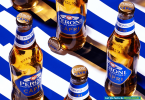Social media aiding at-home status drinking

Consumers still achieve visibility by showing off their drink of choice on social media platforms. In essence, they’re able to down-trade financially without down-trading socially, states IWSR.
Social badging or ‘badge-drinking’ – otherwise known as ‘conspicuous consumption’ – allows consumers to display their social status and wealth through the medium of alcoholic drinks brands.
But now social media is also playing a key role in the evolution of badge-drinking culture today, states leading market analyst IWSR as part of its Global Trends 2020 report.
Social media and badge-drinking culture
The Night-time Economy has been slow to re-open in many markets following the Covid-19 lockdown measures so consumers wanting to broadcast their status have turned to online platforms.
Furthermore as economies slow in the wake of the pandemic, consumers realise they can save money by purchasing alcohol in the local off-licence and then consume it at home.
However they still achieve visibility by showing off their drink of choice on social media platforms. In essence, they’re able to down-trade financially without down-trading socially, states IWSR.
Traditionally, badge-drinking has been inextricably linked to the VIP areas of the on-trade, particularly in parts of Africa and Asia.
Practiced around the world, down-trading is most common in the emerging markets.
“Not only is social media enabling this kind of down-trading to take place but, for status brands, it’s also a hugely important space in which to engage consumers and stay active – particularly through influencers, who’re now a must,” says IWSR’s Research Director for Africa Dan Mettyear.
Social-badging in emerging markets
In some emerging markets smaller home-based gatherings are becoming part of the ‘new normal’, with a proportional amount of badge-drinking potentially transferring to this type event in the longer term, or at least until a vaccine is actively used.
“At home badge-drinking will never completely replace the high-energy exposure of night-time on-trade badge-drinking,” notes Dan Mettyear, “However with decreasing disposable incomes, displays of status through social media will at least provide some refuge for consumers looking to maintain their position.”
While brown spirits are the most common form of status display used for social badging in such badge-drinking markets there are some variations, however, in the badge-drinking cultures of different markets.
South Africa & Nigeria
In South Africa and Nigeria, for example, conspicuous consumption has “fuelled a high-profile, bling-oriented on-trade culture in which bottles on tables are the ultimate status indicator,” says Dan, “Consumers in these markets are highly conscious of how they’re perceived by their peers – especially by members of the sex they are attracted to – and alcoholic drinks play a big role in constructing or projecting a desired image.”
In Asia, badge-drinking is most prevalent in countries such as China where, as in South Africa and Nigeria, it frequently takes the form of bottle service in bars and clubs. Meanwhile, in South Africa, premium blends, malts, Cognac and Champagne are the bottle-serve must-haves and IWSR predicts volume sales growth of 11% between 2019 and 2024 for both Champagne and Malt Scotch.
China
There’s another type of badge-drinking that occurs in China’s traditional on-trade in which consumers can display their status in private booths to a select group of guests. Banqueting also allows consumers to conspicuously showcase their status via high-end bottles of baijiu.
Cognac and Scotch are the most popular status drinks as well as, to a lesser extent, Champagne and luxury vodka. IWSR predicts that volume sales of Cognac and Scotch will grow by 28% and 24% respectively between 2019 and 2024.
Conversely, Single Malts, which are less aligned to ‘peacocking’ and more related to personal choice, have performed well in China since lockdown measures were introduced.
India
Premium blended Scotch is the international status drink of choice for Indian consumers, as long as the distribution is in place and disposable income is available.
Latin America
In Latin America, Scotch remains a key status spirit but premium local categories are now emerging as badge-drinking staples – namely tequila and mezcal (in Mexico), pisco (in Chile) and cachaça (in Brazil). IWSR predicts a 17% growth in mescal volumes between 2019 and 2024.
Meanwhile gin has become a fashionable gifting item. These spirits offer differentiation for consumers who’re looking to stand out.
“Younger Legal Drinking Age consumers in Latin America are also increasingly choosing craft brands as a vehicle for badge-drinking” remarks Luciano Anavi, IWSR’s Senior Analyst for Latin America, “they want to be perceived by their peers as being ‘in the know’.
Key trends
Badge categories that were already in decline, such as blended Scotch in South Korea, are likely to suffer permanent damage from which they don’t recover – similar to what happened following the 2008 financial crash, adds Tommy Keeling, IWSR’s Asia-Pacific Research Director.
“With Single Malts, consumers can share their personal choice through social media – in this medium, what consumers perceive to be a more sophisticated choice such as a Single Malt or fine wine often plays better,” he says.
Badge-drinking, as well as other key trends driving the global beverage alcohol industry, can be explored in greater detail in IWSR’s Global Trends 2020 report.








